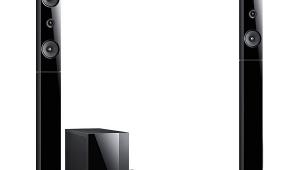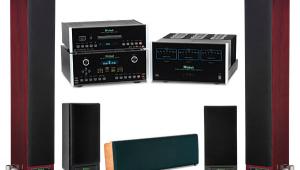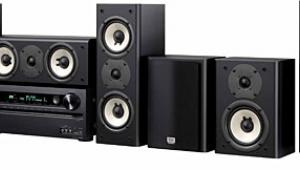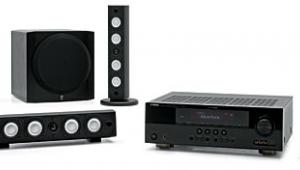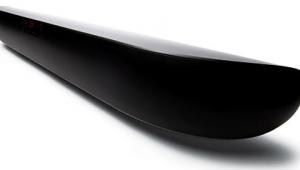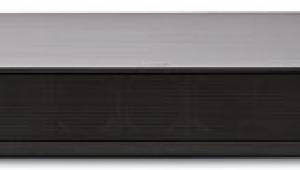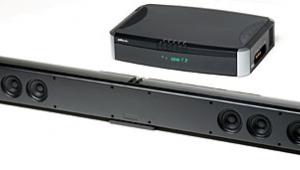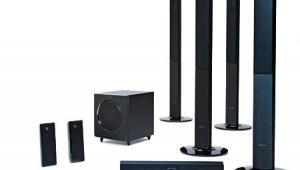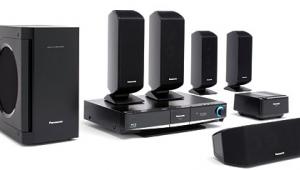Toshiba SD-43HT HTIB
Consumer confession: A little more than three years ago, I bought my first DVD player for $300. It was a basic player in a nondescript black box with none of the now-standard features like progressive-scan video and component video outputs. It couldn't even read recordable CDs.
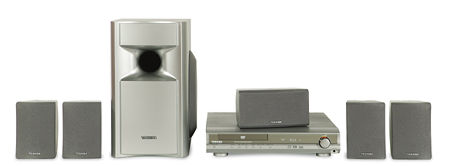
Oh, those early days of DVD. Now, $300 can buy a slimmed-down, tricked-out DVD player that features all of the above and is fluent in MP3 and maybe a high-resolution audio format or two. Or it can get you something more substantial. How about an instant home theater system like Toshiba's SD-43HT, which includes a flashy, silver DVD receiver, five speakers, a subwoofer, and no-fuss, color-coordinated wiring for the setup-impaired?
The SD-43HT and others like it are an inevitable DVD evolution: They're to home theater what the minisystem is to stereo. The all-in-one, one-for-all concept sacrifices size, some fidelity, and a little drama. These systems simply don't play loud enough to rattle the support beams in your house. At this price, though, you can now fit a home theater into budgets, and rooms, that you couldn't before.
Aside from its attractive price, the SD-43HT is one of the more-handsome bargain-basement HTIBs. The DVD receiver looks fresh out of finishing school, with a mirrored face, a silver finish, and zero percent body fat: It's not quite 3 inches thick, and it's little more than 14 inches wide and deep. Loaded inside are Dolby Digital 5.1, DTS, and Dolby Pro Logic II decoding, a 24-bit/96-kilohertz digital-to-analog converter, a single-disc DVD/CD player, an AM/FM tuner with 30 presets, and an amp that is claimed to supply 50 watts to each of the five satellites and 70 to the subwoofer. No wonder it needs independent, extruded-aluminum heatsinks for each channel and an external fan, mounted on the back panel, to blow off some heat.
The home theater novice, to whom the SD-43HT is obviously marketed, will love the front panel's simplicity. The eight controls (possibly a record low) include: from left to right, tiny buttons for on/standby, function, skip forward and skip back (for the DVD player), stop, play/pause, open/close, and (alone on the right) a larger volume control. If this were a $1,000 system, the volume control would probably be bathed in cool-blue illumination, but the SD-43HT works under the light of working man's white. The display, however, remains true blue.
The rear panel also keeps it simple: three types of video connections (component, S-video, and composite); a single digital (optical) input for, perhaps, a CD recorder; two auxiliary analog inputs; and color-coded sockets for the speaker terminals. That color scheme makes wiring the speakers much less menacing. The two wires are embedded in a plug that only fits one way, the right way, into the speaker-terminal socket. You can't possibly screw it up.

The generic speakers are one-trick ponies, each with a single 3-inch driver in a rear-ported, magnetically shielded plastic cabinet. Yes, the SD-43HT is tweeterless. The all-purpose driver, a paper cone with a coated cloth surround, covers the full bandwidth, or as much as it possibly can (100 hertz to 18 kHz) given its size.
Although eliminating the tweeter and electronic crossover might at first seem like a concession to production costs, the single-driver theory, in fact, neatly circumvents the most painful attributes of the low-cost audio system. That is, the glaring, ear-bending high frequencies from a nickel-and-dime tweeter and the sonic colorations imposed by a less-than-optimal crossover. While it lacks the airiness of bigger bookshelf speakers with high-quality tweeters, the SD-43HT is among the smoothest-sounding compact HTIBs I've heard. It's reminiscent, in both single-driver design and sound, of my favorite ultra-low-cost surround sound speaker system, the Henry Kloss–designed Cambridge SoundWorks Ensemble IV. But don't think single drivers are just for speakers on the cheap; there's also a devoted network of fanatics who match low-power tube amplifiers with esoteric speakers that are outfitted with a single, full-range driver, such as those made by Lowther.
The SD-43HT's center-channel speaker is an elongated satellite, stretching almost 12 inches. The subwoofer's flared front port—an aggressive, open-mouth design—leads to an 8-inch, reinforced paper cone driver with a butyl rubber surround. The backside is bare, other than the permanent wiring that leads to the DVD receiver. The sub's output can be controlled only minimally, plus or minus 6 decibels, using the remote's Sound Edit function. For movies, I maxed out the subwoofer's volume in a 20-by-20 room, but I frequently used the convenient Sound Edit to adjust the subwoofer volume on the fly when playing CDs.
The satellites measure slightly more than 7 inches high by 5 wide by 5 deep. The subwoofer reaches only about 14 inches off the floor and, at 8 inches wide, fits into tight corners. The entire boxed system weighs only 44 pounds.

Unless you have trouble uncoiling the speaker wire, it shouldn't take more than 15 or 20 minutes to connect the SD-43HT. If only Toshiba made calibrating the system as easy. The setup procedure is easy enough to follow via the onscreen display, but the built-in test tones (here one second, gone the next) are much too brief to readily match speaker levels. And why do so many HTIB makers refuse to provide basic, one-button volume control for each satellite speaker? With the SD-43HT, you must fiddle with an awkward speaker-balance function. Toshiba says it's easier to adjust only the system's center-channel level, then tweak the front left and right speakers' volume using the balance control. Not for me. I kept returning to the center-channel volume setting, dropping it decibel by decibel, and then checking to hear if it matched the satellites.
Setting the speaker-delay time is also more complex than it should be. You must calculate and compare the distance between speakers, then find the appropriate delay time in microseconds from a chart in the manual. Usually, you merely enter the distance between the listener and each speaker, then let the receiver perform the calculations. To get the speaker levels close, I needed more lengthy calibration tones from a test disc. Additional tests revealed that the SD-43HT's subwoofer had full output at about 50 Hz, although usable bass energy extended to the rated 40 Hz. That's close to standard for a low-priced system.
The external fan, a distraction in some small systems, is quiet enough to go unnoticed, even at close range. The disc drawer hesitates, maybe two seconds, before opening. (The SD-43HT is not for the impatient.) And the remote, while manageable, has a somewhat awkward layout and tiny volume buttons that are best suited to a toddler's fingers.
Still, it doesn't take long to realize that the SD-43HT is a rockin' little HTIB. It loved the Men in Black Superbit edition, even though I had to set the volume control perilously close to maximum. When Tommy Lee Jones implored the big, bad bug to "Eat me!" it sounded like the gulp heard 'round the world. The extreme bass wasn't there, of course, but it didn't matter.
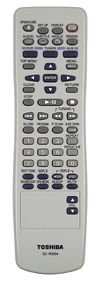 It mattered, though, with the T2 Extreme DVD, the third and best-yet version of Terminator 2 on DVD. This gearhead edition, with a high-definition version that's playable through a DVD-ROM drive, uses a video transfer from a high-definition source. The picture was flawless, looking nothing like a film released in 1991. Even with a dynamic Dolby EX soundtrack, the SD-43HT needed more-potent bass in scenes like "Nuclear Nightmare," when Linda Hamilton gets deep-fried (just an illusion, as it turns out). Sorry, it's tough to pull off the illusion of a nuclear explosion with no bass below 40 Hz.
It mattered, though, with the T2 Extreme DVD, the third and best-yet version of Terminator 2 on DVD. This gearhead edition, with a high-definition version that's playable through a DVD-ROM drive, uses a video transfer from a high-definition source. The picture was flawless, looking nothing like a film released in 1991. Even with a dynamic Dolby EX soundtrack, the SD-43HT needed more-potent bass in scenes like "Nuclear Nightmare," when Linda Hamilton gets deep-fried (just an illusion, as it turns out). Sorry, it's tough to pull off the illusion of a nuclear explosion with no bass below 40 Hz.
Punch-Drunk Love, a Superbit disc packaged without the familiar Superbit sleeve, underscores the SD-43HT's strengths: With no big-ticket special effects, it can highlight Jon Brion's atmospheric score and the vivid cinematography favored by director Paul Thomas Anderson (who suggests watching the film with your TV's color contrast boosted). The select special effects, like the overturning car and bizarre drop-off of a piano by Checker Cab in the opening, startle with their suddenness.
The SD-43HT's reserved sonics—no glaring highs, a smooth if somewhat recessed midrange, and modest but somewhat loosely defined bass—make the switch from soundtrack to CD easy. After listening to Norah Jones sail through "Cold, Cold Heart" on the CD layer of the Come Away with Me SACD, it's easy to determine that, although not audiophile quality, by any standard of $300 HTIBs, this is superior sound. Yes, it's a little thin. And yes, the bass needs some tweaking via Sound Edit. But Toshiba obviously knows the difference between cheap hi-fi and inexpensive hi-fi.
The SD-43HT adequately conveys the distinctive, rich tone of tenor saxophonist Mark Turner, a jazz musician who deserves wider recognition, on the direct-to-two-track Ballad Session album. It loses something, however, when Turner defers to Larry Grenadier for a bass solo on "Skylark." At best, the bass is ill-defined. But again, by HTIB standards, it's not too bad.
Poor Ron Sexsmith comes out the loser with the oddly engineered Cobblestone Runway. Although it's not entirely the SD-43HT's fault, he sounds a little too much like Fozzy Bear on "Least That I Can Do." Give the SD-43HT something more elegantly recorded, like the CD layer of dobro master Jerry Douglas' Lookout for Hope SACD, and you'll know what it can do. The guitar/dobro combination on "The Suit" not only sounds correct, but guest vocalist James Taylor falls directly in the system's midrange sweet spot. Note, however, that achieving this level of correctness requires virtually shutting down the subwoofer for proper balance.
The big disappointment on the audio side was DPLII, an essential format that decodes two-channel sources like CD into five-channel surround sound. The SD-43HT has extensive DPLII options for an HTIB—four modes and customizable effects settings for panorama, dimension, and width—but no combination matched two-channel stereo. In every case, the stereo reproduction had more punch and body and sounded more dynamic. A CD-R of Joni Mitchell's Travelogue demonstrated the SD-43HT's ability to play recordable discs, but it also marked the first time I've preferred stereo to DPLII on an HTIB. In stereo, Mitchell's vocals were slightly recessed, but they were much more pleasant than what the distant, weak-kneed DPLII offered. This is a true mystery. It may or may not be a question of total power output. Expect more life from DPLII in a smaller room that's less taxing on the system.
When confined to a den, bedroom, apartment, or dorm room, Toshiba's SD-43HT is a slick entry into basic home theater at a street price that's about one-third less than a Bose Wave radio. These days, the dollar goes a long way with DVD.
Highlights
• Hot looks, hotter price
• Smooth highs: The HTIB glare is gone

- Log in or register to post comments
